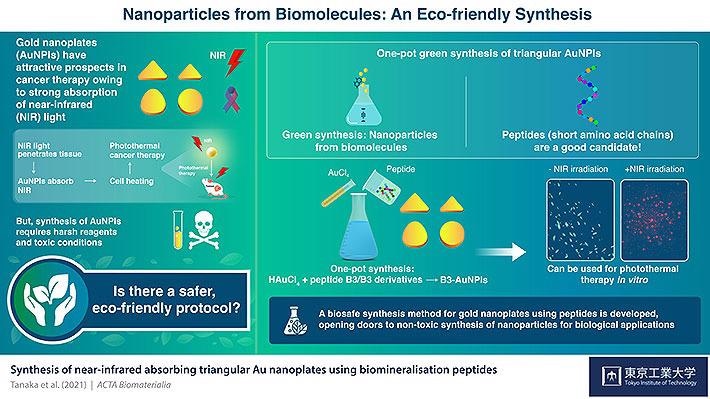Jun 29 2021
Using a biomolecule known as B3 peptide, researchers from the Tokyo Institute of Technology (Tokyo Tech) have developed an eco-friendly process to synthesize gold nanoparticles that have improved morphology for near-infrared light absorption.
 Synthesis of near-infrared absorbing triangular Au nanoparticles with biomineralization peptides. Image Credit: Tokyo Institute of Technology.
Synthesis of near-infrared absorbing triangular Au nanoparticles with biomineralization peptides. Image Credit: Tokyo Institute of Technology.
The article explains the synthesis of circular and triangular nanoplates as well as their effectiveness in destroying cancer cells by transforming absorbed light into heat. This breakthrough provides valuable information for developing a non-invasive cancer therapy.
In cancer treatment, the effectiveness of a certain technique is established by its potential to sustain non-cancerous cells. In other words, if the collateral damage is more, the side-effects of treatment will also be more. Therefore, a perfect scenario is the one where cancer cells alone are targeted and destroyed.
Considering this aspect, photothermal therapy has emerged as a potential approach because of its minimally invasive nature. In this therapy, cancer cells embedded with gold nanoparticles are heated up and killed using near-infrared (NIR) light that is intensely absorbed by the gold nanoparticles.
Because NIR light is able to penetrate biological tissues, it can illuminate the gold nanoparticles within the body and turn them into nano-sized cell heating agents.
Masayoshi Tanaka, Professor, Tokyo Institute of Technology
Professor Tanaka investigates nanomaterials for biomedical applications.
Due to their efficient absorption of NIR light, gold nanoparticles (AuNPls) are extremely attractive as photothermal therapeutic agents. The synthesis of these nanoparticles, however, demands highly toxic conditions and harsh reagents, rendering the process quite dangerous.
In the latest study, Professor Tanaka and his colleagues from the University of Leeds in the UK and Chung-Ang University in Korea have now resolved this issue by creating a safer and more eco-friendly process for AuNPl synthesis. The study results have been published in the ACTA Biomaterialia journal.
The researchers took a cue from a process, known as “biomineralization,” in which biomolecules are used to produce metal nanoparticles with tunable structures.
Peptides, or short chains of amino acids, are particularly attractive candidates for this purpose because of their relatively small size and stability. However, their use for producing Au nanoparticles with optimized structures for efficient NIR absorption has not yet been reported.
Masayoshi Tanaka, Professor, Tokyo Institute of Technology
Encouraged by this outcome, the researchers started their analysis by identifying peptides that are appropriate for the mineralization of AuNPls. After identifying more than 100 peptides, they decided to assess the potential of a peptide called B3 for producing AuNPls with tunable structures that can act as photothermal conversion agents.
In a process known as “one-pot synthesis”, the researchers mixed HAuCl4, a gold salt, as well as B3 peptide and its derivatives at different concentrations in a buffer solution (an aqueous solution that is resistant to pH changes) at neutral pH and produced circular- and triangular-shaped AuNPls that have varied levels of NIR absorption based on the concentration of peptides.
The effects of the AuNPIs were tested on cultured cancer cells under irradiated conditions, and the team found that these AuNPIs have the preferred therapeutic effects. In addition, when the peptide was characterized using B3 derivatives, the researchers observed that the AuNPI structure was governed by an amino acid known as histidine.
These findings provide not only an easy and green synthetic method for AuNPls but also insight into the regulation of peptide-based nanoparticle synthesis. This could open doors to new techniques for non-toxic synthesis of nanoparticle therapeutic agents.
Masayoshi Tanaka, Professor, Tokyo Institute of Technology
The researchers could have indeed struck gold with gold nanoparticles.
Journal Reference:
Tanaka., M, et al. (2021) Synthesis of near-infrared absorbing triangular Au nanoplates using biomineralisation peptides. ACTA Biomaterialia. doi.10.1016/j.actbio.2021.06.010.